An Approach toward the Realization of a Through-Thickness Glass Fiber/Epoxy Thermoelectric Generator
Abstract
:1. Introduction
- S = the Seebeck coefficient in μV/K
- ΔV = the generated TE voltage in mV
- ΔT = the externally applied temperature difference in K
- PF = the power factor in μW/mK2
- σ = the electrical conductivity in S/m
- ZT = dimensionless figure of merit
- T = the absolute temperature
- κ = thermal conductivity in W/m·K
2. Materials and Methods
2.1. Materials
2.2. Synthesis of TE Nanomaterial and Ink Preparation
2.3. Manufacturing of the GFRP Laminate with the Through-Thickness TEG Functionality
2.4. Characterization Methodologies
- TH = the temperature of the hot side in K
- TC = the temperature of the cold side in K
- = ZT calculated at the average temperature between the hot and the cold side
- Pmax = maximum power output in nW
- VTEG = the TE open-circuit voltage in mV
- RTEG = internal electrical resistance of the TEG in Ohm
- P = the output power in nW
- I = the output current that passes through the load in μA
- RLoad = externally applied load resistances in Ohm
3. Results and Discussion
3.1. Characterization of the Inorganic-Organic Nanomaterial and the Coated GF Fabric
3.2. Characterization of the TEG GFRP Laminate
4. Conclusions
Author Contributions
Funding

Institutional Review Board Statement
Informed Consent Statement
Data Availability Statement
Conflicts of Interest
References
- Martín-González, M.; Caballero-Calero, O.; Díaz-Chao, P. Nanoengineering thermoelectrics for 21st century: Energy harvesting and other trends in the field. Renew. Sustain. Energy Rev. 2013, 24, 288–305. [Google Scholar] [CrossRef]
- Ball, A.D.; Gu, F.; Cattley, R.; Wang, X.; Tang, X. Energy harvesting technologies for achieving self-powered wireless sensor networks in machine condition monitoring: A review. Sensors (Switzerland) 2018, 18, 4113. [Google Scholar] [CrossRef] [Green Version]
- Dilhac, J.M.; Monthéard, R.; Bafleur, M.; Boitier, V.; Durand-Estèbe, P.; Tounsi, P. Implementation of thermoelectric generators in airliners for powering battery-free wireless sensor networks. J. Electron. Mater. 2014, 43, 2444–2451. [Google Scholar] [CrossRef] [Green Version]
- Zoui, M.A.; Bentouba, S.; Stocholm, J.G.; Bourouis, M. A review on thermoelectric generators: Progress and applications. Energies 2020, 13, 3606. [Google Scholar] [CrossRef]
- Kraemer, D.; Poudel, B.; Feng, H.P.; Caylor, J.C.; Yu, B.; Yan, X.; Ma, Y.; Wang, X.; Wang, D.; Muto, A.; et al. High-performance flat-panel solar thermoelectric generators with high thermal concentration. Nat. Mater. 2011, 10, 532–538. [Google Scholar] [CrossRef] [PubMed]
- Lee, J.J.; Yoo, D.; Park, C.; Choi, H.H.; Kim, J.H. All organic-based solar cell and thermoelectric generator hybrid device system using highly conductive PEDOT:PSS film as organic thermoelectric generator. Sol. Energy 2016, 134, 479–483. [Google Scholar] [CrossRef]
- Lee, D.; Kim, I.; Kim, D. Hybrid tribo-thermoelectric generator for effectively harvesting thermal energy activated by the shape memory alloy. Nano Energy 2021, 82, 105696. [Google Scholar] [CrossRef]
- Boudouris, B.W. Engineering optoelectronically active macromolecules for polymer-based photovoltaic and thermoelectric devices. Curr. Opin. Chem. Eng. 2013, 2, 294–301. [Google Scholar] [CrossRef]
- Zi, Y.; Wang, Z.L. Nanogenerators: An emerging technology towards nanoenergy. APL Mater. 2017, 5, 074103. [Google Scholar] [CrossRef] [Green Version]
- Liu, L. Feasibility of large-scale power plants based on thermoelectric effects. New J. Phys. 2014, 16, 123019. [Google Scholar] [CrossRef] [Green Version]
- Zappa, W.; Junginger, M.; Van Den Broek, M.; Cover, C.L. Is a 100% renewable European power system feasible by 2050? Appl. Energy 2019, 233–234, 1027–1050. [Google Scholar] [CrossRef]
- Vineis, C.J.; Shakouri, A.; Majumdar, A.; Kanatzidis, M.G. Nanostructured thermoelectrics: Big efficiency gains from small features. Adv. Mater. 2010, 22, 3970–3980. [Google Scholar] [CrossRef]
- Cho, C.; Wallace, K.L.; Tzeng, P.; Hsu, J.H.; Yu, C.; Grunlan, J.C. Outstanding Low Temperature Thermoelectric Power Factor from Completely Organic Thin Films Enabled by Multidimensional Conjugated Nanomaterials. Adv. Energy Mater. 2016, 6, 1–8. [Google Scholar] [CrossRef]
- Snyder, G.J.; Toberer, E.S. Complex thermoelectric materials. Nat. Mater. 2008, 7, 105–114. [Google Scholar] [CrossRef]
- Madan, D.; Wang, Z.; Chen, A.; Juang, R.C.; Keist, J.; Wright, P.K.; Evans, J.W. Enhanced performance of dispenser printed MA n-type Bi2Te 3 composite thermoelectric generators. ACS Appl. Mater. Interfaces 2012, 4, 6117–6124. [Google Scholar] [CrossRef] [PubMed]
- Cao, Z.; Koukharenko, E.; Tudor, M.J.; Torah, R.N.; Beeby, S.P. Flexible screen printed thermoelectric generator with enhanced processes and materials. Sens. Actuators A Phys. 2016, 238, 196–206. [Google Scholar] [CrossRef]
- Shah, K.W.; Wang, S.X.; Soo, D.X.Y.; Xu, J. One-dimensional nanostructure engineering of conducting polymers for thermoelectric applications. Appl. Sci. 2019, 9, 1422. [Google Scholar] [CrossRef] [Green Version]
- Dörling, B.; Ryan, J.D.; Craddock, J.D.; Sorrentino, A.; El Basaty, A.; Gomez, A.; Garriga, M.; Pereiro, E.; Anthony, J.E.; Weisenberger, M.C.; et al. Photoinduced p- to n-type Switching in Thermoelectric Polymer-Carbon Nanotube Composites. Adv. Mater. 2016, 28, 2782–2789. [Google Scholar] [CrossRef] [PubMed] [Green Version]
- Wei, Q.; Mukaida, M.; Kirihara, K.; Naitoh, Y.; Ishida, T. Recent progress on PEDOT-based thermoelectric materials. Materials (Basel) 2015, 8, 732–750. [Google Scholar] [CrossRef]
- Kandemir, A.; Ozden, A.; Cagin, T.; Sevik, C. Thermal conductivity engineering of bulk and one-dimensional Si-Ge nanoarchitectures. Sci. Technol. Adv. Mater. 2017, 18, 187–196. [Google Scholar] [CrossRef] [PubMed] [Green Version]
- Chen, W.Y.; Shi, X.L.; Zou, J.; Chen, Z.G. Wearable fiber-based thermoelectrics from materials to applications. Nano Energy 2021, 81, 105684. [Google Scholar] [CrossRef]
- Allison, L.K.; Andrew, T.L. A Wearable All-Fabric Thermoelectric Generator. Adv. Mater. Technol. 2019, 4, 1–7. [Google Scholar] [CrossRef]
- Jung, K.K.; Jung, Y.; Choi, C.J.; Lee, J.M.; Ko, J.S. Flexible thermoelectric generator with polydimethyl siloxane in thermoelectric material and substrate. Curr. Appl. Phys. 2016, 16, 1442–1448. [Google Scholar] [CrossRef]
- Mytafides, C.K.; Tzounis, L.; Karalis, G.; Formanek, P.; Paipetis, A.S. High-Power All-Carbon Fully Printed and Wearable SWCNT-Based Organic Thermoelectric Generator. ACS Appl. Mater. Interfaces 2021, 13, 11151–11165. [Google Scholar] [CrossRef]
- Kim, S.J.; We, J.H.; Cho, B.J. A wearable thermoelectric generator fabricated on a glass fabric. Energy Environ. Sci. 2014, 7, 1959–1965. [Google Scholar] [CrossRef]
- Wei, J.; Nie, Z.; He, G.; Hao, L.; Zhao, L.; Zhang, Q. Energy harvesting from solar irradiation in cities using the thermoelectric behavior of carbon fiber reinforced cement composites. RSC Adv. 2014, 4, 48128–48134. [Google Scholar] [CrossRef]
- Tzounis, L.; Liebscher, M.; Fuge, R.; Leonhardt, A.; Mechtcherine, V. P- and n-type thermoelectric cement composites with CVD grown p- and n-doped carbon nanotubes: Demonstration of a structural thermoelectric generator. Energy Build. 2019, 191, 151–163. [Google Scholar] [CrossRef]
- Karalis, G.; Tzounis, L.; Lambrou, E.; Gergidis, L.N.; Paipetis, A.S. A carbon fiber thermoelectric generator integrated as a lamina within an 8-ply laminate epoxy composite: Efficient thermal energy harvesting by advanced structural materials. Appl. Energy 2019, 253, 113512. [Google Scholar] [CrossRef]
- Blackburn, J.L.; Ferguson, A.J.; Cho, C.; Grunlan, J.C. Carbon-Nanotube-Based Thermoelectric Materials and Devices. Adv. Mater. 2018, 30, 1–35. [Google Scholar] [CrossRef] [PubMed]
- Kroon, R.; Mengistie, D.A.; Kiefer, D.; Hynynen, J.; Ryan, J.D.; Yu, L.; Müller, C. Thermoelectric plastics: From design to synthesis, processing and structure-property relationships. Chem. Soc. Rev. 2016, 45, 6147–6164. [Google Scholar] [CrossRef] [Green Version]
- Tzounis, L.; Hegde, M.; Liebscher, M.; Dingemans, T.; Pötschke, P.; Paipetis, A.S.; Zafeiropoulos, N.E.; Stamm, M. All-aromatic SWCNT-Polyetherimide nanocomposites for thermal energy harvesting applications. Compos. Sci. Technol. 2018, 156, 158–165. [Google Scholar] [CrossRef]
- Karalis, G.; Mytafides, C.; Polymerou, A.; Tsirka, K.; Tzounis, L.; Gergidis, L.; Paipetis, A.S. Hierarchical Reinforcing Fibers for Energy Harvesting Applications—A Strength Study. Key Eng. Mater. 2020, 827, 252–257. [Google Scholar] [CrossRef]
- Karalis, G.; Tsirka, K.; Tzounis, L.; Mytafides, C.; Koutsotolis, L.; Paipetis, A.S. Epoxy/Glass Fiber Nanostructured p- and n-Type Thermoelectric Enabled Model Composite Interphases. Appl. Sci. 2020, 10, 5352. [Google Scholar] [CrossRef]
- Paluvai, N.R.; Mohanty, S.; Nayak, S.K. Synthesis and Modifications of Epoxy Resins and Their Composites: A Review. Polym. Plast. Technol. Eng. 2014, 53, 1723–1758. [Google Scholar] [CrossRef]
- Gibson, R.F. A review of recent research on mechanics of multifunctional composite materials and structures. Compos. Struct. 2010, 92, 2793–2810. [Google Scholar] [CrossRef]
- De Luca, F.; Clancy, A.J.; Carrero, N.R.; Anthony, D.B.; De Luca, H.G.; Shaffer, M.S.P.; Bismarck, A. Increasing carbon fiber composite strength with a nanostructured “brick-and-mortar” interphase. Mater. Horiz. 2018, 5, 668–674. [Google Scholar] [CrossRef] [Green Version]
- Gkikas, G.; Barkoula, N.M.; Paipetis, A.S. Effect of dispersion conditions on the thermo-mechanical and toughness properties of multi walled carbon nanotubes-reinforced epoxy. Compos. Part B Eng. 2012, 43, 2697–2705. [Google Scholar] [CrossRef]
- Qian, H.; Greenhalgh, E.S.; Shaffer, M.S.P.; Bismarck, A. Carbon nanotube-based hierarchical composites: A review. J. Mater. Chem. 2010, 20, 4751–4762. [Google Scholar] [CrossRef]
- Bekas, D.G.; Paipetis, A.S. Damage monitoring in nanoenhanced composites using impedance spectroscopy. Compos. Sci. Technol. 2016, 134, 96–105. [Google Scholar] [CrossRef]
- Foteinidis, G.; Tsirka, K.; Tzounis, L.; Baltzis, D.; Paipetis, A.S. The role of synergies of MWCNTs and Carbon Black in the enhancement of the electrical and mechanical response of modified epoxy resins. Appl. Sci. 2019, 9, 3757. [Google Scholar] [CrossRef] [Green Version]
- Orfanidis, S.; Papavassiliou, G.; Paipetis, A.S. Microcapsule-based self-healing materials: Healing efficiency and toughness reduction vs. capsule size. Compos. Part B 2019, 171, 78–86. [Google Scholar] [CrossRef]
- Qian, H.; Kucernak, A.R.; Greenhalgh, E.S.; Bismarck, A.; Shaffer, M.S.P. Multifunctional structural supercapacitor composites based on carbon aerogel modified high performance carbon fiber fabric. ACS Appl. Mater. Interfaces 2013, 5, 6113–6122. [Google Scholar] [CrossRef] [Green Version]
- Han, J.H.; Zhang, H.; Chen, M.J.; Wang, D.; Liu, Q.; Wu, Q.L.; Zhang, Z. The combination of carbon nanotube buckypaper and insulating adhesive for lightning strike protection of the carbon fiber/epoxy laminates. Carbon N. Y. 2015, 94, 101–113. [Google Scholar] [CrossRef]
- Sung, D.H.; Kang, G.H.; Kong, K.; Kim, M.; Park, H.W.; Park, Y. Bin Characterization of thermoelectric properties of multifunctional multiscale composites and fiber-reinforced composites for thermal energy harvesting. Compos. Part B Eng. 2016, 92, 202–209. [Google Scholar] [CrossRef]
- Han, S.; Chung, D.D.L. Through-thickness thermoelectric power of a carbon fiber/epoxy composite and decoupled contributions from a lamina and an interlaminar interface. Carbon N. Y. 2013, 52, 30–39. [Google Scholar] [CrossRef]
- Han, S.; Chung, D.D.L. Carbon fiber polymer-matrix structural composites exhibiting greatly enhanced through-thickness thermoelectric figure of merit. Compos. Part A Appl. Sci. Manuf. 2013, 48, 162–170. [Google Scholar] [CrossRef]
- Li, C.; Sun, P.; Liu, C.; Xu, J.; Wang, T.; Wang, W.; Hou, J.; Jiang, F. Fabrication of flexible SWCNTs-Te composite films for improving thermoelectric properties. J. Alloys Compd. 2017, 723, 642–648. [Google Scholar] [CrossRef]
- Choi, J.; Lee, K.; Park, C.R.; Kim, H. Enhanced thermopower in flexible tellurium nanowire films doped using single-walled carbon nanotubes with a rationally designed work function. Carbon N. Y. 2015, 94, 577–584. [Google Scholar] [CrossRef]
- Park, H.; Son, W.; Lee, S.H.; Kim, S.; Lee, J.J.; Cho, W.; Choi, H.H.; Kim, J.H. Aqueous chemical synthesis of tellurium nanowires using a polymeric template for thermoelectric materials. CrystEngComm 2015, 17, 1092–1097. [Google Scholar] [CrossRef]
- Wei, J.; Wen, X.; Zhu, F. Influence of Surfactant on the Morphology and Photocatalytic Activity of Anatase TiO2 by Solvothermal Synthesis. J. Nanomater. 2018, 2018, 1–7. [Google Scholar] [CrossRef]
- Thilagavathi, T.; Geetha, D. Nano ZnO structures synthesized in presence of anionic and cationic surfactant under hydrothermal process. Appl. Nanosci. 2014, 4, 127–132. [Google Scholar] [CrossRef] [Green Version]
- von Lukowicz, M.; Abbe, E.; Schmiel, T.; Tajmar, M. Thermoelectric Generators on Satellites—An Approach for Waste Heat Recovery in Space. Energies 2016, 9, 541. [Google Scholar] [CrossRef]
- ASTM INTERNATIONAL Standard Test Methods for Flexural Properties of Unreinforced and Reinforced Plastics and Electrical Insulating Materials. D790. Annu. B ASTM Stand. 2002, pp. 1–12. Available online: https://www.astm.org/Standards/D790 (accessed on 25 April 2021).
- Roy, A.; Amin, K.R.; Tripathi, S.; Biswas, S.; Singh, A.K.; Bid, A.; Ravishankar, N. Manipulation of Optoelectronic Properties and Band Structure Engineering of Ultrathin Te Nanowires by Chemical Adsorption. ACS Appl. Mater. Interfaces 2017, 9, 19462–19469. [Google Scholar] [CrossRef]
- Tsirka, K.; Karalis, G.; Paipetis, A.S. Raman Strain Sensing and Interfacial Stress Transfer of Hierarchical CNT-Coated Carbon Fibers. J. Mater. Eng. Perform. 2018, 27, 5095–5101. [Google Scholar] [CrossRef]
- Liang, F.; Qian, H. Synthesis of tellurium nanowires and their transport property. Mater. Chem. Phys. 2009, 113, 523–526. [Google Scholar] [CrossRef]
- Choi, J.; Lee, J.Y.; Lee, H.; Park, C.R.; Kim, H. Enhanced thermoelectric properties of the flexible tellurium nanowire film hybridized with single-walled carbon nanotube. Synth. Met. 2014, 198, 340–344. [Google Scholar] [CrossRef]
- Moriarty, G.P.; Wheeler, J.N.; Yu, C.; Grunlan, J.C. Increasing the thermoelectric power factor of polymer composites using a semiconducting stabilizer for carbon nanotubes. Carbon N. Y. 2012, 50, 885–895. [Google Scholar] [CrossRef]
- Zaia, E.W.; Sahu, A.; Zhou, P.; Gordon, M.P.; Forster, J.D.; Aloni, S.; Liu, Y.S.; Guo, J.; Urban, J.J. Carrier Scattering at Alloy Nanointerfaces Enhances Power Factor in PEDOT:PSS Hybrid Thermoelectrics. Nano Lett. 2016, 16, 3352–3359. [Google Scholar] [CrossRef]
- Marshall, G.J.; Mahony, C.P.; Rhodes, M.J.; Daniewicz, S.R.; Tsolas, N.; Thompson, S.M. Thermal Management of Vehicle Cabins, External Surfaces, and Onboard Electronics: An Overview. Engineering 2019, 5, 954–969. [Google Scholar] [CrossRef]
- Khaled, M.; Harambat, F.; Peerhossaini, H. Underhood thermal management: Temperature and heat flux measurements and physical analysis. Appl. Therm. Eng. 2010, 30, 590–598. [Google Scholar] [CrossRef] [Green Version]
- Inayat, S.B.; Rader, K.R.; Hussain, M.M. Thermoelectricity from Window Glasses. Sci. Rep. 2012, 2, 841. [Google Scholar] [CrossRef] [PubMed] [Green Version]
- Lu, Z.; Zhang, H.; Mao, C.; Li, C.M. Silk fabric-based wearable thermoelectric generator for energy harvesting from the human body. Appl. Energy 2016, 164, 57–63. [Google Scholar] [CrossRef]
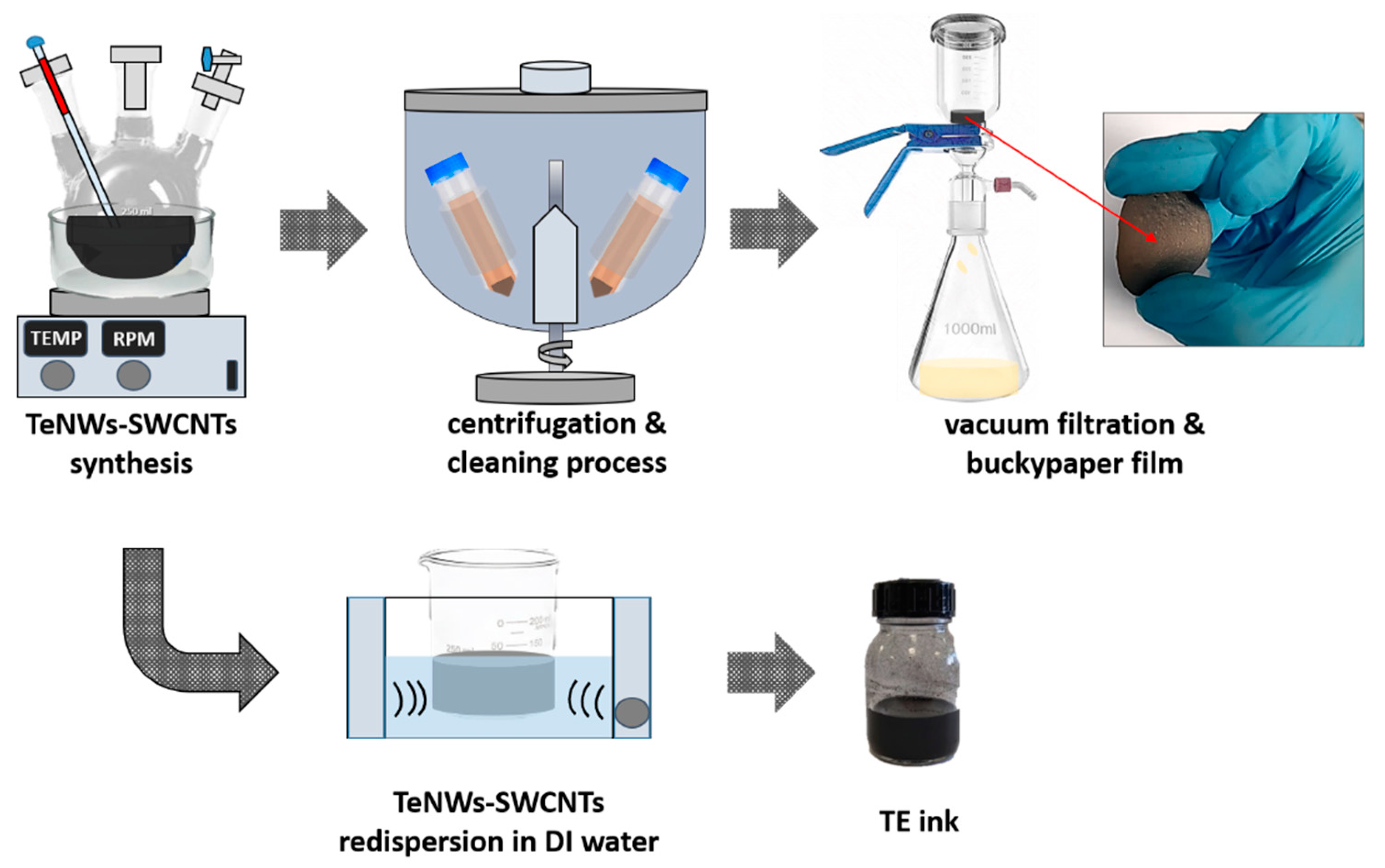
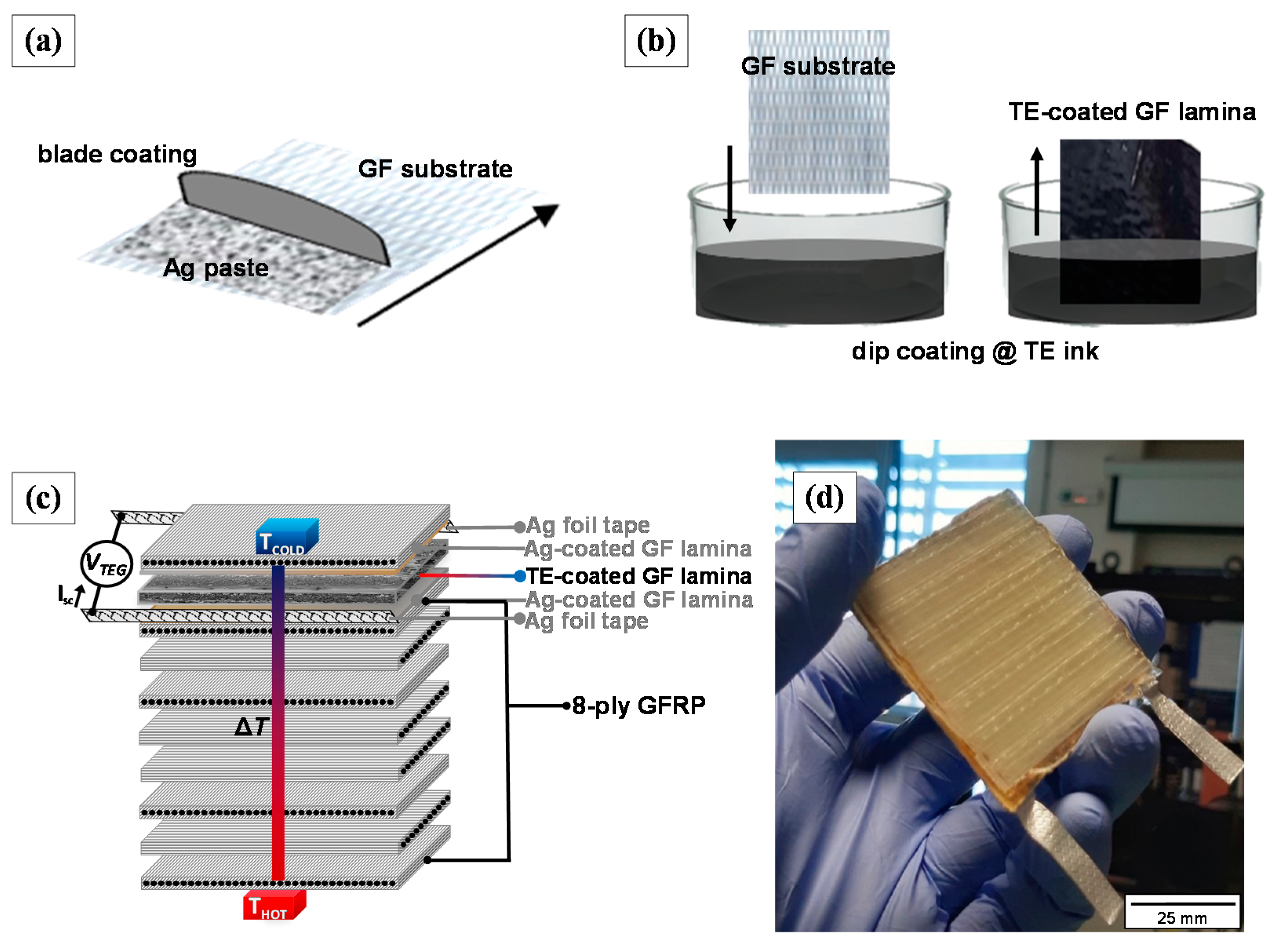
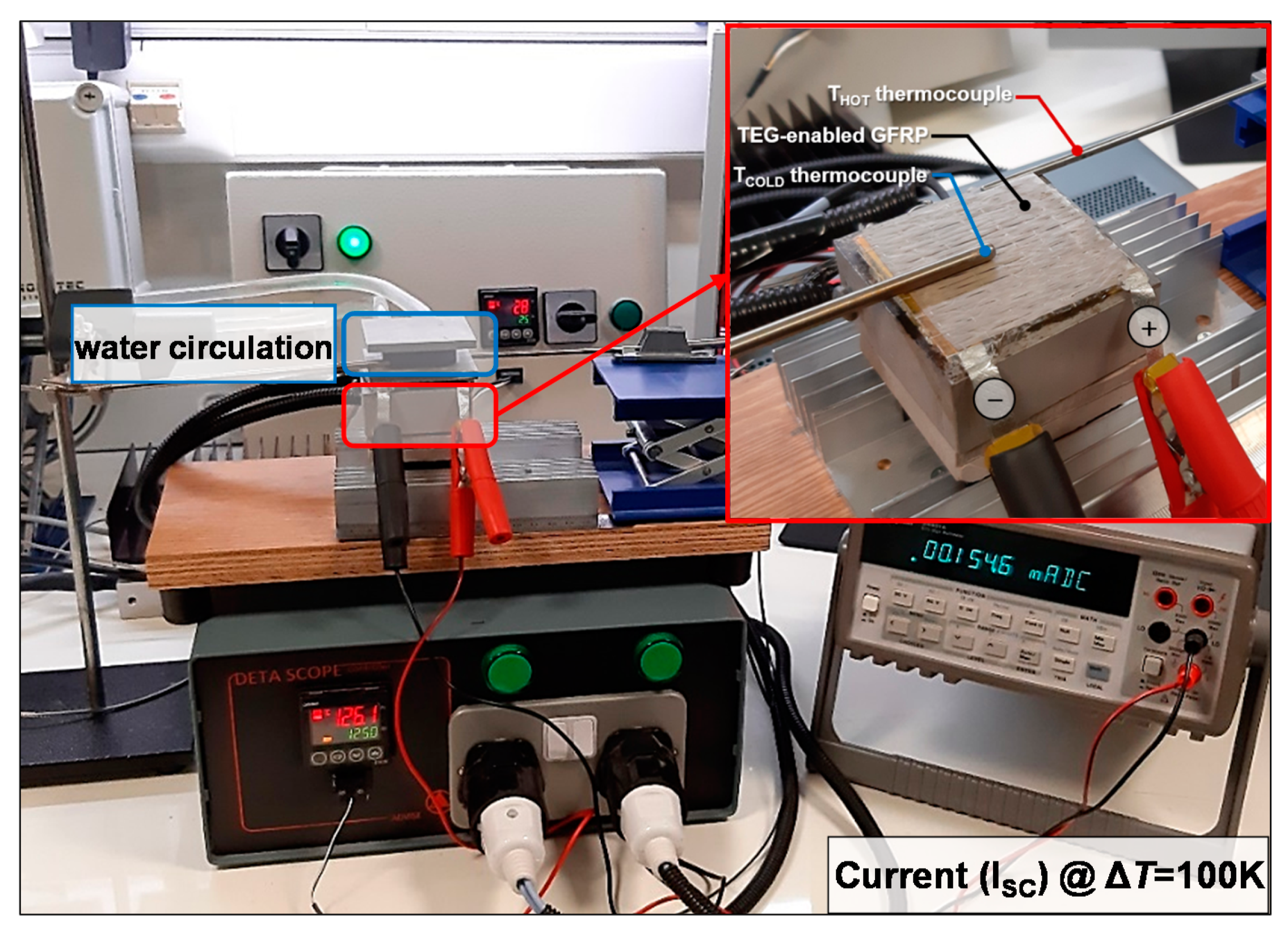
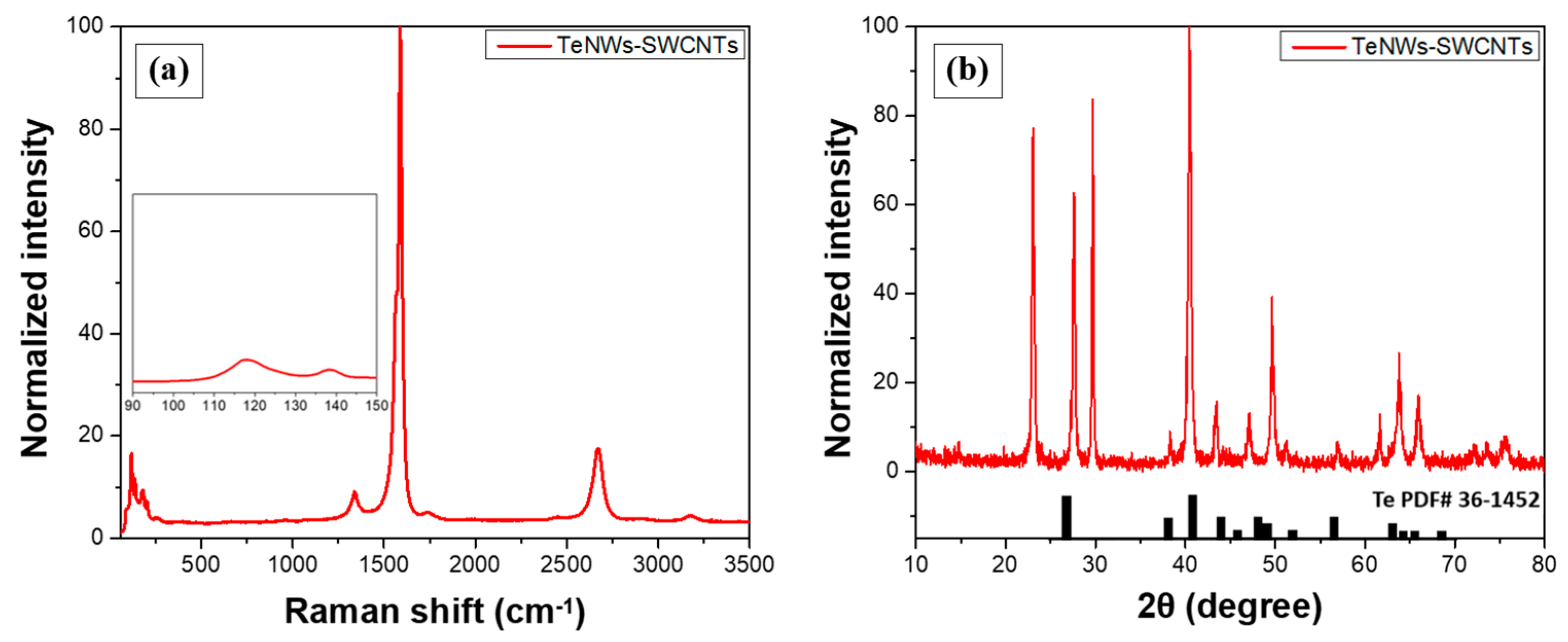
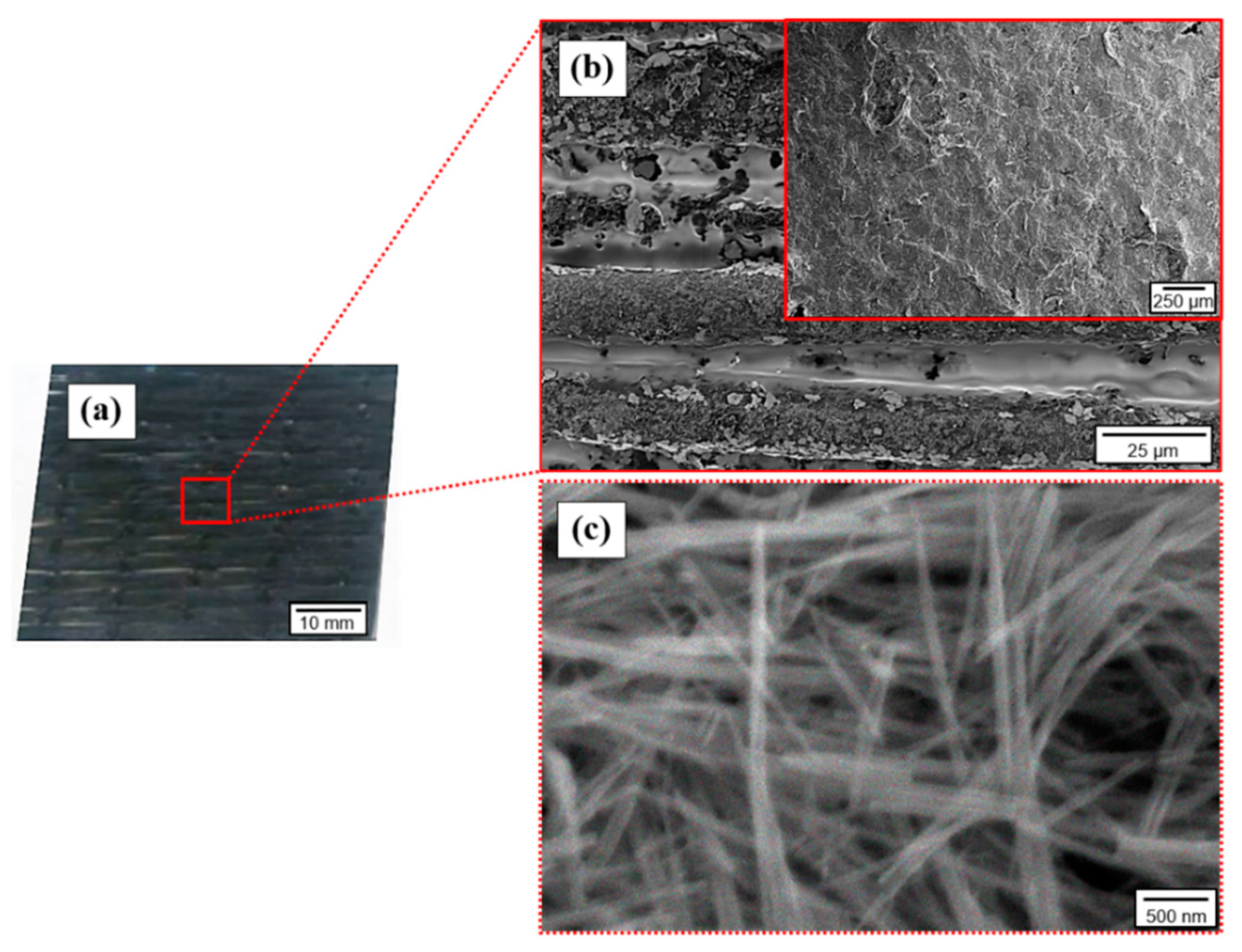

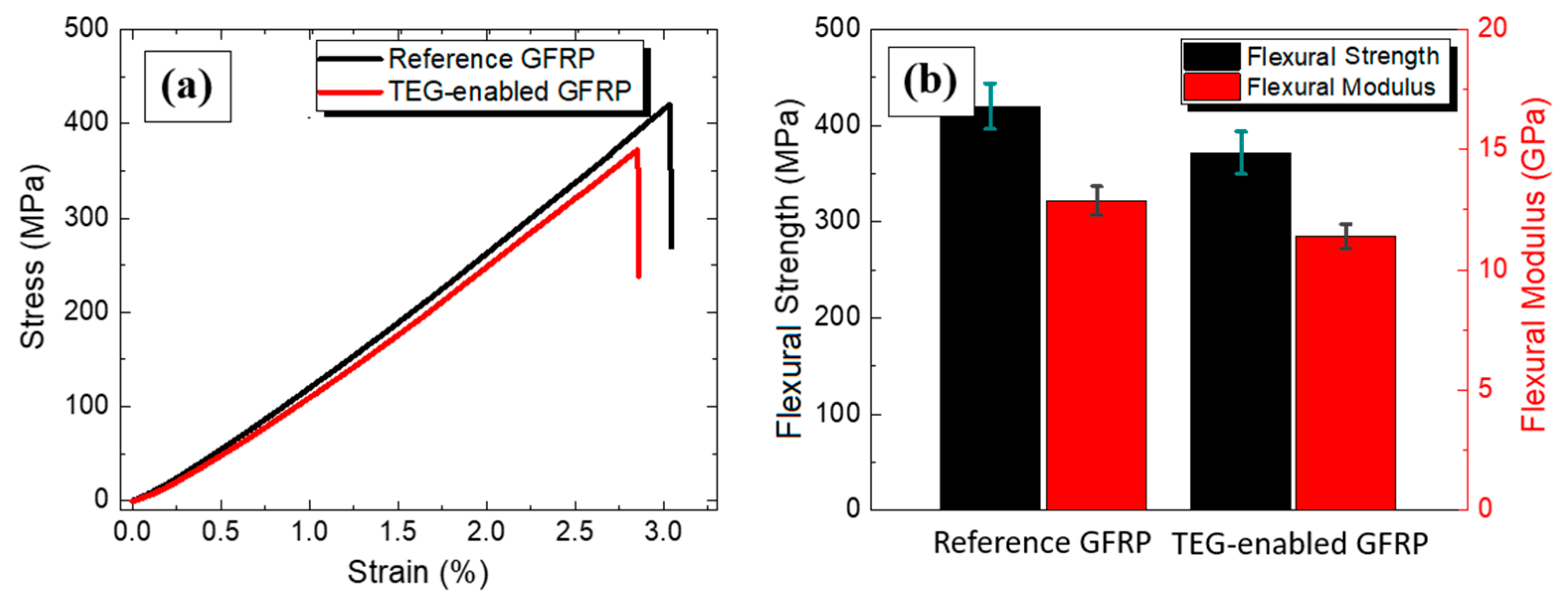
| TE Material | σ | S | PF | κ | ZT | η |
|---|---|---|---|---|---|---|
| S/m | μV/K | μW/m·K2 | W/(m·K) | - | % | |
| TeNWs | 8.4 ± 0.6 | +302 ± 8 | 0.77 | 0.28 | 0.001 | 0.008 |
| TeNWs-SWCNTs | 9200 ± 5 | +80 ± 4 | 58.88 | 0.26 | 0.080 | 0.590 |
| ΔT (K) | RTEG (Ohm) | VTEG (mV) | Isc (μA) | Pmax (nW) |
|---|---|---|---|---|
| 0 | 8.30 ± 0.10 | - | - | - |
| 50 | 9.15 ± 0.15 | 0.76 ± 0.13 | 82.67 ± 0.18 | 15.78 |
| 75 | 9.33 ± 0.24 | 1.10 ± 0.17 | 119.84 ± 0.24 | 32.42 |
| 100 | 9.56 ± 0.32 | 1.44 ± 0.22 | 154.60 ± 0.38 | 54.22 |
Publisher’s Note: MDPI stays neutral with regard to jurisdictional claims in published maps and institutional affiliations. |
© 2021 by the authors. Licensee MDPI, Basel, Switzerland. This article is an open access article distributed under the terms and conditions of the Creative Commons Attribution (CC BY) license (https://creativecommons.org/licenses/by/4.0/).
Share and Cite
Karalis, G.; Mytafides, C.K.; Tzounis, L.; Paipetis, A.S.; Barkoula, N.-M. An Approach toward the Realization of a Through-Thickness Glass Fiber/Epoxy Thermoelectric Generator. Materials 2021, 14, 2173. https://doi.org/10.3390/ma14092173
Karalis G, Mytafides CK, Tzounis L, Paipetis AS, Barkoula N-M. An Approach toward the Realization of a Through-Thickness Glass Fiber/Epoxy Thermoelectric Generator. Materials. 2021; 14(9):2173. https://doi.org/10.3390/ma14092173
Chicago/Turabian StyleKaralis, George, Christos K. Mytafides, Lazaros Tzounis, Alkiviadis S. Paipetis, and Nektaria-Marianthi Barkoula. 2021. "An Approach toward the Realization of a Through-Thickness Glass Fiber/Epoxy Thermoelectric Generator" Materials 14, no. 9: 2173. https://doi.org/10.3390/ma14092173







